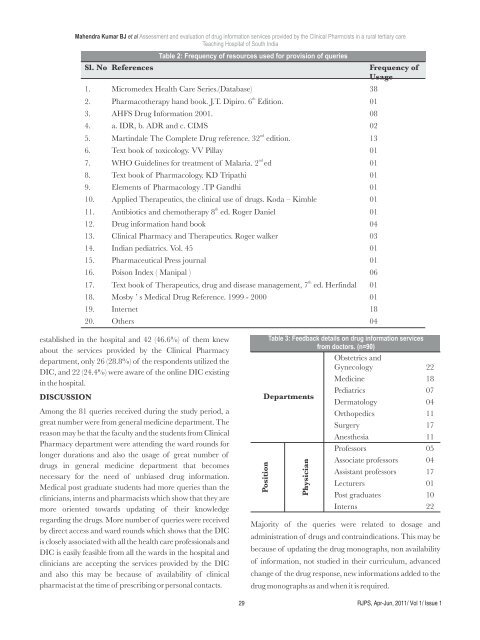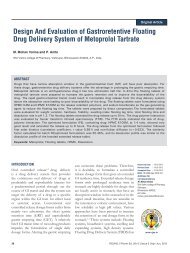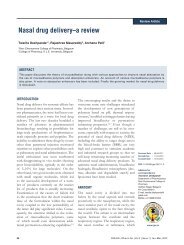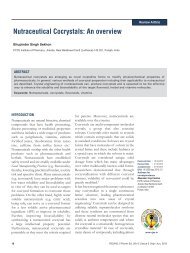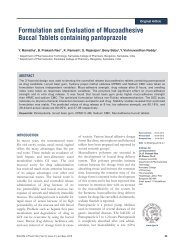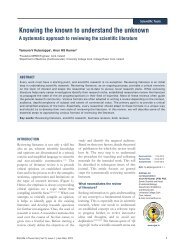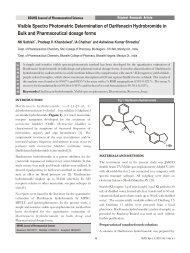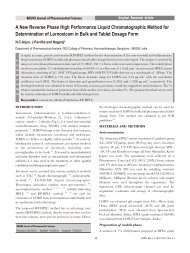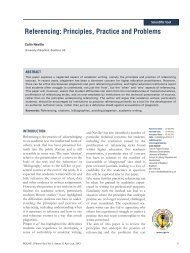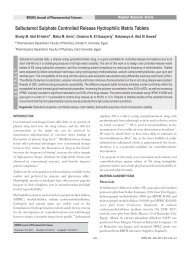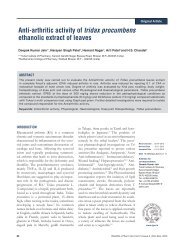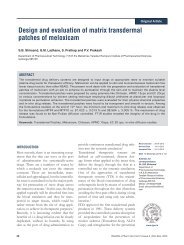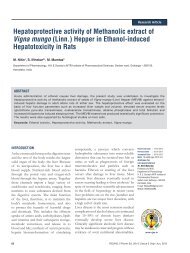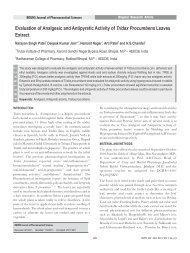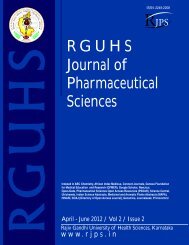final .cdr
final .cdr
final .cdr
Create successful ePaper yourself
Turn your PDF publications into a flip-book with our unique Google optimized e-Paper software.
Mahendra Kumar BJ et al Assessment and evaluation of drug information services provided by the Clinical Pharmcists in a rural tertiary care<br />
Teaching Hospital of South India<br />
Table 2: Frequency of resources used for provision of queries<br />
Sl. No References Frequency of<br />
Usage<br />
1. Micromedex Health Care Series.(Database) 38<br />
th<br />
2. Pharmacotherapy hand book. J.T. Dipiro. 6 Edition. 01<br />
3. AHFS Drug Information 2001. 08<br />
4. a. IDR, b. ADR and c. CIMS 02<br />
nd<br />
5. Martindale The Complete Drug reference. 32 edition. 13<br />
6. Text book of toxicology. VV Pillay 01<br />
nd<br />
7. WHO Guidelines for treatment of Malaria. 2 ed 01<br />
8. Text book of Pharmacology. KD Tripathi 01<br />
9. Elements of Pharmacology .TP Gandhi 01<br />
10. Applied Therapeutics, the clinical use of drugs. Koda – Kimble 01<br />
th<br />
11. Antibiotics and chemotherapy 8 ed. Roger Daniel 01<br />
12. Drug information hand book 04<br />
13. Clinical Pharmacy and Therapeutics. Roger walker 03<br />
14. Indian pediatrics. Vol. 45 01<br />
15. Pharmaceutical Press journal 01<br />
16. Poison Index ( Manipal ) 06<br />
th<br />
17. Text book of Therapeutics, drug and disease management, 7 ed. Herfindal 01<br />
18. Mosby ’ s Medical Drug Reference. 1999 - 2000 01<br />
19. Internet 18<br />
20. Others 04<br />
established in the hospital and 42 (46.6%) of them knew<br />
about the services provided by the Clinical Pharmacy<br />
department, only 26 (28.8%) of the respondents utilized the<br />
DIC, and 22 (24.4%) were aware of the online DIC existing<br />
in the hospital.<br />
DISCUSSION<br />
Among the 81 queries received during the study period, a<br />
great number were from general medicine department. The<br />
reason may be that the faculty and the students from Clinical<br />
Pharmacy department were attending the ward rounds for<br />
longer durations and also the usage of great number of<br />
drugs in general medicine department that becomes<br />
necessary for the need of unbiased drug information.<br />
Medical post graduate students had more queries than the<br />
clinicians, interns and pharmacists which show that they are<br />
more oriented towards updating of their knowledge<br />
regarding the drugs. More number of queries were received<br />
by direct access and ward rounds which shows that the DIC<br />
is closely associated with all the health care professionals and<br />
DIC is easily feasible from all the wards in the hospital and<br />
clinicians are accepting the services provided by the DIC<br />
and also this may be because of availability of clinical<br />
pharmacist at the time of prescribing or personal contacts.<br />
29<br />
Table 3: Feedback details on drug information services<br />
from doctors. (n=90)<br />
Obstetrics and<br />
Gynecology 22<br />
Medicine 18<br />
Departments<br />
Pediatrics<br />
Dermatology<br />
07<br />
04<br />
Orthopedics 11<br />
Surgery 17<br />
Anesthesia 11<br />
Professors 05<br />
Associate professors 04<br />
Assistant professors 17<br />
Lecturers 01<br />
Post graduates 10<br />
Interns 22<br />
Position<br />
Physician<br />
Majority of the queries were related to dosage and<br />
administration of drugs and contraindications. This may be<br />
because of updating the drug monographs, non availability<br />
of information, not studied in their curriculum, advanced<br />
change of the drug response, new informations added to the<br />
drug monographs as and when it is required.<br />
RJPS, Apr-Jun, 2011/ Vol 1/ Issue 1


